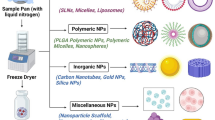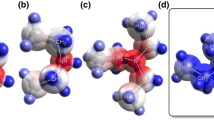Abstract
Purpose
To present a novel approach of greatly enhancing aqueous solubility of a model weakly basic drug, haloperidol, by using weak acids that would not form salts with the drug and to attain physically stable form of amorphous drug by drying such aqueous solutions.
Method
Aqueous solubility of haloperidol in presence of increasing concentrations of four different weak organic acids (malic, tartaric, citric, fumaric) were determined. Several concentrated aqueous solutions with differing drug-to-acid molar ratios were dried in vacuum oven, and dried materials were characterized by DSC, powder XRD, dissolution testing, and stability study.
Result
Acids were selected such that they would not form salts with haloperidol. Haloperidol solubility increased greatly with increased concentrations of malic, tartaric and citric acids, reaching >300 mg/g of solution. In contrast to the haloperidol HCl aqueous solubility of 4 mg/g, this may be called supersolubilization. Fumaric acid did not cause such solubilization as it had low water solubility. Dried solids formed dispersions of amorphous haloperidol in acids that were either amorphous or partially crystalline. Amorphous haloperidol was physically stable and had better dissolution rate than HCl salt.
Conclusion
A novel method of drug solubilization in aqueous media by acid–base interaction is presented. Physically stable amorphous systems of drugs may also be prepared by using this organic solvent-free approach.






Similar content being viewed by others
References
Lipinski CA. Drug-like properties and the causes of poor solubility and poor permeability. J Pharmacol Toxicol Methods. 2000;44(1):235–49.
Lipinski CA. Poor aqueous solubility—an industry wide problem in drug discovery. Am Pharm Rev. 2002;5:82–5.
Lipinski CA. Compound properties and drug quality. In: Wermuth CG, editor. The practice of medicinal chemistry. Chapter 22. 3rd ed. London: Academic; 2008. p. 481–90. 4.
Vasanthavada M, Tong WQ, Serajuddin ATM. Development of solid dispersions for poorly water-soluble drug. In: Liu R, editor. Water-insoluble drug formulations. 2nd ed. New York: Informa Healthcare; 2008. p. 149–84.
Serajuddin ATM, Li P, Haefele T. Development of lipid-based drug delivery systems for poorly water-soluble drugs as viable oral dosage forms—present status and future prospects. Am Pharm Rev. 2008;11:34.
General notices and requirements (section 5:30). In: United States Pharmacopoeia-National Formulary USP34-NF29. Rockville: United States Pharmacopoeial Convention; 2011, p. 6.
Merisko-Liversidge E, Liversidge GG, Cooper ER. Nanosizing: a formulation approach for poorly-water-soluble compounds. Eur J Pharm Sci. 2003;18(2):113–20.
Kesisoglou F, Panmai S, Wu Y. Nanosizing—oral formulation development and biopharmaceutical evaluation. Adv Drug Deliv Rev. 2007;59(7):631–44.
Li P, Zhao L. Developing early formulations: practice and perspective. Int J Pharm. 2007;341(1–2):1–19.
Serajuddin ATM. Salt formation to improve drug solubility. Adv Drug Deliv Rev. 2007;59(7):603–16.
Hancock BC, Parks M. What is the solubility advantage for amorphous pharmaceuticals? Pharm Res. 2000;17(4):397–404.
Yu L. Amorphous pharmaceutical solids: preparation, characterization and stabilization. Adv Drug Deliv Rev. 2001;48(1):27–42.
Bhugra C, Pikal MJ. Role of thermodynamic, molecular, and kinetic factors in crystallization from the amorphous state. J Pharm Sci. 2008;97(4):1329–49.
Chiou WL, Riegelman S. Pharmaceutical applications of solid dispersion systems. J Pharm Sci. 1971;60(9):1281–302.
Serajuddin ATM. Solid dispersion of poorly water–soluble drugs: early promises, subsequent problems, and recent breakthroughs. J Pharm Sci. 1999;88(10):1058–66.
Porter C, Trevaskis NL, Charman WN. Lipids and lipid-based formulations: optimizing the oral delivery of lipophilic drugs. Nature Rev. 2007;6(3):231–48.
Prajapati HN, Dalrymple DM, Serajuddin ATM. A comparative evaluation of mono-, di-and triglyceride of medium chain fatty acids by lipid/surfactant/water phase diagram, solubility determination and dispersion testing for application in pharmaceutical dosage form development. Pharm Res. 2012;29(1):285–305.
Patel DP, Li P, Serajuddin ATM. Enhanced microemulsion formation in lipid-based drug delivery systems by combining mono-esters of medium chain fatty acids with di- and tri-esters. J Excipients Food Chem. 2012;3(2):29–44.
Peltonen L, Hirvonen J. Pharmaceutical nanocrystals by nanomilling: critical process parameters, particle fracturing and stabilization methods. J Pharm Pharmacol. 2010;62(11):1569–79.
Kim Y, Oksanen DA, Massefski Jr W, Blake JF, Duffy EM, Chrunyk B. Inclusion complexation of ziprasidone mesylate with β–cyclodextrin sulfobutyl ether. J Pharm Sci. 1998;87(12):1560–7.
Thombre AG, Herbig SM, Alderman JA. Improved ziprasidone formulations with enhanced bioavailability in the fasted state and a reduced food effect. Pharm Res. 2011;289(12):3159–70.
Pouton CW. Formulation of poorly water-soluble drugs for oral administration: physicochemical and physiological issues and the lipid formulation classification system. Eur J Pharm Sci. 2006;29(3–4):278–87.
Li S, Wong SM, Sethia S, Almoazen H, Joshi YM, Serajuddin ATM. Investigation of solubility and dissolution of a free base and two different salt forms as a function of pH. Pharm Res. 2005;22(4):628–35.
Greco K, Mcnamara DP, Bogner R. Solution–mediated phase transformation of salts during dissolution: investigation using haloperidol as a model drug. J Pharm Sci. 2011;100(7):2755–68.
Kramer S, Flynn G. Solubility of organic hydrochlorides. J Pharm Sci. 1972;61(12):1896–904.
Anderson BD, Flora KP. Preparation of water-soluble compounds through salt formation. In: Wermuth CG, editor. The practice of medicinal chemistry. 1st ed. London: Academic; 1996. p. 739–54.
Pudipeddi M, Serajuddin ATM, Grant DJW, Stahl P. Salt selection strategies. In: Stahl PH, Wermuth CG, editors. IUPAC handbook of pharmaceutical salts: properties, selection, and use. Chapter 6. Zurich: Verlag Helvetica Chimica Acta; 2002. p. 135–60.
Serajuddin ATM, Pudipeddi M. Solubility and dissolution of weak acids, bases and salts. In: Stahl PH, Wermuth CG, editors. IUPAC handbook of pharmaceutical salts: properties, selection, and use. Chapter 2. Zurich: Verlag Helvetica Chimica Acta; 2002. p. 19–39.
The Merck Index, an encyclopedia of chemicals, drugs and biologicals. 14th ed. Rahway (NJ): Merck & Co; 2006, p. 2326, 4287, 5707, 9070.
Author information
Authors and Affiliations
Corresponding author
Electronic supplementary material
Below is the link to the electronic supplementary material.
ESM 1
(PDF 309 kb)
Rights and permissions
About this article
Cite this article
Singh, S., Parikh, T., Sandhu, H.K. et al. Supersolubilization and Amorphization of a Model Basic Drug, Haloperidol, by Interaction with Weak Acids. Pharm Res 30, 1561–1573 (2013). https://doi.org/10.1007/s11095-013-0994-7
Received:
Accepted:
Published:
Issue Date:
DOI: https://doi.org/10.1007/s11095-013-0994-7




